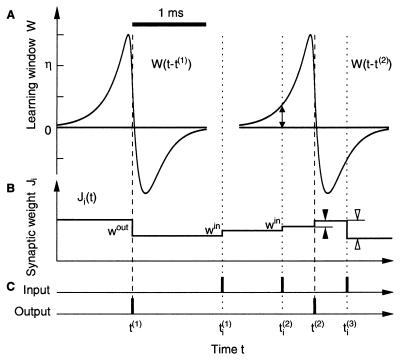Figure 2.
Spike-based learning. (A) Two plots of the learning
window W in units of the learning parameter η as a
function of the temporal difference between spike arrival at time
t at synapse i (e.g., t
=
t ,
m = 1, 2, 3; dotted lines) and postsynaptic firing
at times t(1) and
t(2) (dashed lines). Scale bar = 1 ms.
(B) Time course of the synaptic weight
Ji(t) evoked through
input spikes at synapse i and postsynaptic output spikes
(vertical bars in C). The output spike at time
t(1) decreases
Ji by an amount
wout. The input at
t
,
m = 1, 2, 3; dotted lines) and postsynaptic firing
at times t(1) and
t(2) (dashed lines). Scale bar = 1 ms.
(B) Time course of the synaptic weight
Ji(t) evoked through
input spikes at synapse i and postsynaptic output spikes
(vertical bars in C). The output spike at time
t(1) decreases
Ji by an amount
wout. The input at
t and
t
and
t increase
Ji by win
each. There is no influence of the learning window W
because these input spikes are too far away in time from
t(1). The output spike at
t(2), however, follows the input at
t
increase
Ji by win
each. There is no influence of the learning window W
because these input spikes are too far away in time from
t(1). The output spike at
t(2), however, follows the input at
t closely enough, so
that, at t(2),
Ji is changed by
wout < 0 plus
W(t
closely enough, so
that, at t(2),
Ji is changed by
wout < 0 plus
W(t − t(2)) > 0 (double-headed arrow),
the sum of which is positive (filled arrowheads). Similarly, the input
at t
− t(2)) > 0 (double-headed arrow),
the sum of which is positive (filled arrowheads). Similarly, the input
at t leads to a
decrease win +
W(t
leads to a
decrease win +
W(t −
t(2)) < 0 (open arrowheads). The
assumption of instantaneous and discontinuous weight changes can be
relaxed to delayed and continuous ones that are triggered by spikes,
provided weight changes are fast when compared with the time scale of
learning (46). If the integral
∫
−
t(2)) < 0 (open arrowheads). The
assumption of instantaneous and discontinuous weight changes can be
relaxed to delayed and continuous ones that are triggered by spikes,
provided weight changes are fast when compared with the time scale of
learning (46). If the integral
∫ W(s)
ds is sufficiently negative, then one can drop
wout (49).
W(s)
ds is sufficiently negative, then one can drop
wout (49).

